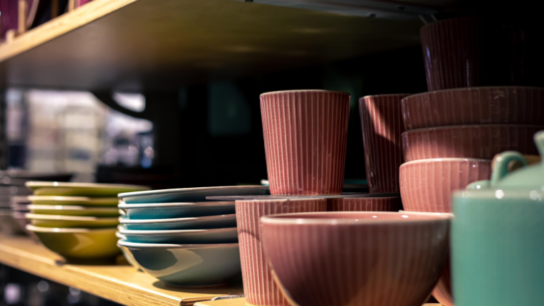An organized kitchen not only enhances efficiency but also makes cooking and meal preparation more enjoyable. Maximizing space, decluttering, and creating functional storage solutions are key aspects of kitchen organization. In this guide, we’ll delve into effective kitchen organization tips that help you maximize efficiency and streamline your culinary experience.
Subtitles:
- Strategic Storage Solutions
- Efficient Kitchen Workflow
Strategic Storage Solutions
1. Utilize Vertical Space
Maximize vertical space in your kitchen by installing wall-mounted shelves, racks, and cabinets. Use these spaces to store cookware, utensils, spices, and small appliances, keeping them easily accessible yet out of the way.
Tips:
- Floating Shelves: Install floating shelves above countertops or near cooking areas to store frequently used items such as spices, cookbooks, and decorative pieces.
- Wall-mounted Racks: Use wall-mounted racks or pegboards to hang pots, pans, and utensils, freeing up cabinet and drawer space.
- Overhead Cabinets: Utilize overhead cabinets for storing less frequently used items or seasonal cookware. Use labeled containers or bins for organization.
2. Drawer Dividers and Organizers
Use drawer dividers and organizers to keep utensils, gadgets, and cutlery neatly arranged and easily accessible. Customizable dividers allow you to create compartments that fit your specific kitchen tools.
Tips:
- Utensil Trays: Use utensil trays with dividers to separate and organize spoons, forks, knives, and cooking utensils in drawers.
- Drawer Inserts: Invest in drawer inserts for organizing spices, baking tools, measuring cups, and other kitchen essentials. Choose adjustable inserts for flexibility.
- Cutlery Organizers: Use cutlery trays with compartments for sorting and storing knives, forks, and spoons. Consider magnetic knife strips for safely storing and displaying knives.
3. Pantry Organization
Organize your pantry shelves with clear bins, baskets, and labels to categorize and access pantry staples, canned goods, snacks, and dry ingredients efficiently. Group similar items together for easy retrieval.
Tips:
- Clear Containers: Transfer pantry items like flour, sugar, rice, and pasta into clear, airtight containers to maintain freshness and visibility. Label containers for easy identification.
- Basket Storage: Use baskets or bins to group similar items such as baking supplies, snacks, condiments, and canned goods. Stackable baskets optimize vertical space.
- Shelf Organizers: Install shelf organizers or risers to create additional storage tiers in the pantry. Arrange items by frequency of use, with frequently used items at eye level.
Efficient Kitchen Workflow
1. Zone Your Kitchen
Create distinct zones in your kitchen for cooking, prepping, cleaning, and storage. Designate specific areas for each task to streamline workflow and reduce clutter.
Tips:
- Cooking Zone: Place pots, pans, cooking utensils, and spices near the stove for easy access during meal preparation. Use hooks or racks for hanging utensils within reach.
- Prep Area: Designate a clear countertop space for food prep, chopping, and assembling ingredients. Keep cutting boards, knives, mixing bowls, and measuring tools nearby.
- Cleaning Station: Organize cleaning supplies, dishwashing detergent, sponges, and towels near the sink for efficient cleanup after cooking. Use under-sink organizers for storage.
2. Declutter Countertops
Keep countertops clutter-free by storing frequently used items in designated areas and minimizing decorative objects or appliances that are not in regular use. Clear countertops create a spacious and functional workspace.
Tips:
- Essential Appliances: Keep essential countertop appliances such as coffee makers, toasters, and food processors within easy reach but away from the main workspace. Store less frequently used appliances in cabinets or pantries.
- Minimalist Decor: Limit decorative items on countertops to maintain a clean and uncluttered look. Use wall-mounted decor or shelves for displaying items without taking up counter space.
- Daily Use Storage: Use countertop storage solutions such as canisters, jars, or baskets for storing frequently used items like cooking oils, spices, and utensils. Keep these items organized and easily accessible.
3. Labeling and Inventory
Labeling containers, shelves, and drawers helps maintain organization and facilitates quick inventory checks. Use clear labels, color-coding, and inventory lists to track pantry items, spices, and perishables.
Tips:
- Labeling Systems: Use adhesive labels, chalkboard labels, or marker pens to label containers, jars, and bins in the pantry, refrigerator, and freezer. Include expiration dates or use-by dates for perishable items.
- Inventory Lists: Maintain digital or written inventory lists for pantry staples, spices, and canned goods. Update lists regularly to track usage and restocking needs.
- Color-Coding: Assign colors to labels or containers based on categories (e.g., baking supplies, snacks, condiments) for visual organization. Use color-coded labels for easy identification.
4. Regular Maintenance and Review
Schedule regular maintenance sessions to declutter, clean, and reorganize kitchen spaces. Conduct periodic reviews of storage systems, inventory, and workflow to identify areas for improvement and optimization.
Tips:
- Seasonal Cleanup: Declutter and organize kitchen spaces seasonally to remove expired items, reorganize storage, and assess usability of tools and appliances.
- Maintenance Checks: Check and adjust storage systems, shelves, and drawer organizers periodically to ensure functionality and efficiency. Repair or replace damaged or worn-out storage solutions.
- Workflow Evaluation: Evaluate kitchen workflow, from meal preparation to cleanup, to identify bottlenecks or inefficiencies. Make adjustments to layout, storage, or processes for improved efficiency.
By implementing strategic storage solutions and optimizing kitchen workflow, you can maximize efficiency, reduce clutter, and create a well-organized and functional kitchen space. Incorporate these tips into your kitchen organization routine to streamline meal preparation, cooking, and cleanup, making your kitchen a joy to work in.






